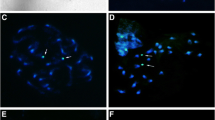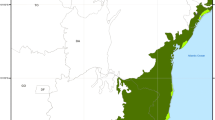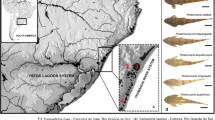Abstract
Studies on cytogenetic diversity within the Alstroemeriaceae family along its intercontinental distribution are scarce when comparing species of their four genera. This study aimed at exploring the cytogenetic diversity of the family along their geographical distribution, including species that inhabit Oceania and South America. Using quantitative and qualitative methods, we analysed 50 species of the four genera (24% of the species of the family), comparing cytogenetic characters such as chromosome number, karyotype morphology and asymmetry, location of chromosome satellites, total haploid length, meiotic behaviour, C and FISH banding, and DNA C-values. We concur with other authors in that generic delimitation based on chromosome number is clear among Alstroemeria (2n = 16) and Bomarea (2n = 18), both belonging to Alstroemerioideae. Moreover, these two genera have different chromosome numbers compared to those of Luzuriaga and Drymophila (both 2n = 20) belonging to Luzuriagoideae. The above observations were also supported by the phylogeny reconstructed here. In addition, analyses on karyotype morphology and asymmetry have determined gradual differences in nuclear architecture among genera and species. We concluded that the cytogenetic diversity described within Alstroemeriaceae is concentrated mainly in South America, which is to be expected given the higher species diversity that has been described for that continent. Although the presence of three chromosome numbers within Alstroemeriaceae has no relation with their wide geographical distribution in two continents, an appreciable variation was observed in karyotype morphology and asymmetry, total haploid length and cytomolecular features when the species were compared along their geographical range.



Similar content being viewed by others
References
Aagesen L, Sanso M (2003) The phylogeny of the Alstroemeriaceae, based on morphology, rps16 Intron, and rbcL sequence data. Syst Bot 28:47–69
Alzate F (2016) El género Bomarea (Alstroemeriaceae) en la Flora de Colombia. (F. y N. Academia Colombiana de Ciencias Exactas, Ed.). Gente Nueva, Bogotá. https://repositorio.accefyn.org.co/handle/001/61
Alzate F, Mort M, Ramírez M (2008) Phylogenetic analyses of Bomarea (Alstroemeriaceae) based on combined analyses of nrDNA ITS, psbA-trnH, rpoB-trnC and matK sequences. Taxon 57:853–862. https://doi.org/10.1002/tax.573014
Arroyo S, Leuenberger B (1988b) A note on Luzuriaga marginata (Philesiaceae) from Paragonia. Herbertia 44:17–21
Arroyo S, Leuenberger B (1988a) Leaf morphology and taxonomic history of Luzuriaga (Philesiaceae). Willdenowia 17:159–172
Arroyo-Leuenberger S (2001) Flora fanerogámica argentina Philesiaceae, Asteliaceae y Luzuriagaceae. Pro-Flora CONICET 72:1–7
Baeza C, Silva R (2016) Análisis citológico de una población de Bomarea salsilla (L.) Mirb (Alstroemeriaceae) de la Región del Biobío. Chile. Chilean J Agric Anim Sci 32:184–188. https://doi.org/10.4067/S0719-38902016005000002
Baeza C, Schrader O, Ruiz E, Negritto M (2006) Análisis comparative del cariotipo en poblaciones de Alstroemeria ligtu subsp. ligtu y A. ligtu subsp. simsii (Alstroemeriaceae) de Chile. Darwiniana 44:313–318. https://doi.org/10.14522/darwiniana.2014.442.105
Baeza C, Schrader O, Budahn H (2007a) Characterization of geographically isolated accessions in five Alstroemeria L. species (Chile) using FISH of tandemly repeated DNA sequences and RAPD analysis. Pl Syst Evol 269:1–14. https://doi.org/10.1007/s00606-007-0591-5
Baeza C, Schrader O, Ruiz E, Negritto M (2007b) Análisis comparativo del cariotipo en poblaciones de Alstroemeria aurea R. Graham (Alstroemeriaceae) de Chile. Gayana Bot 64:33–39. https://doi.org/10.4067/S0717-66432007000100004
Baeza C, Alzate F, Negritto M, Ruiz E (2008a) El cariotipo de Bomarea patinii Baker subsp. patinii (Alstroemeriaceae). Gayana Bot 65:233–236. https://doi.org/10.4067/S0717-66432008000200010
Baeza C, Schrader O, Ruiz E, Negritto M (2008b) Alstroemeria presliana Herb. (Alstroemeriaceae) in Chile from a cytogenetic perspective. Chilean J Agric Res 68:328–333. https://doi.org/10.4067/S0718-58392008000400002
Baeza C, Ruiz E, Novoa P (2010a) Karyotype of Alstroemeria diluta Her. Bayer subsp. chrysantha (Alstroemeriaceae). Chilean J Agric Res 70:667–669
Baeza C, Ruiz E, Negritto M (2010b) Comparative karyotypic analysis in the Alstroemeria hookeri Lodd. (Alstroemeriaceae) complex sensu Bayer (1987). Genet Molec Biol 33:119–124. https://doi.org/10.1590/S1415-47572010005000012
Baeza C, Rojas G, Ruiz E (2011a) El cariotipo fundamental de Alstroemeria patagonica (Alstroemeriaceae). Bol Soc Argent Bot 46:313–315. https://doi.org/10.31055/1851.2372.v55.n4
Baeza C, Espejo J, Ruiz E (2011b) El cariotipo fundamental de Alstroemeria versicolor Ruiz et Pav. (Alstromeriaecae). Gayana Bot 68:327–329. https://doi.org/10.4067/S0717-66432011000200023
Baeza C, Ruiz E, Rosas M (2012) Es Leontochir ovallei Phil. (Alstroemeriaceae) un género distinto a Bomarea Mirbel? Consideraciones citológicas. Chilean J Agri Anim Sci 28:63–67. https://doi.org/10.4067/S0719-38902016005000002
Baeza C, Finot V, Ruiz E (2015a) Comparative karyotype analysis of populations in the Alstroemeria presliana Herbert (Alstroemeriaceae) complex in Chile. Genet Molec Biol 38:199–204. https://doi.org/10.1590/S1415-4757382220140277
Baeza C, Finot V, Ruiz E, Carrasco P, Novoa P (2015b) Comparative karyotypic analysis and cytotaxonomy in the Alstroemeria ligtu L. (Alstroemeriaceae) complex of Chile. Brazil J Bot 39:305–313. https://doi.org/10.1007/s40415-015-0220-4
Baeza C, Finot V, Ruiz E, Carrasco P, Novoa P, Rosas M, Toro-Núñez O (2018a) Cytotaxonomic study of the Chilean endemic complex Alstroemeria magnifica Herb. (Alstroemeriaceae). Genet Molec Biol 41:434–441. https://doi.org/10.1590/1678-4685-gmb-2017-0157
Baeza C, Toro O, Ruiz E, Finot V, Carrasco P, Villalobos N (2018b) Polimorfismo de tamaño entre cromosomas homólogos, un caso extremo en Alstroemeria pulchra Sims. (Alstroemeriaceae), especie endémica de Chile. Gayana Bot 75:663–666. https://doi.org/10.4067/S0717-66432018000200663
Baeza C, Carrasco P, Villalobos N (2020) Número cromosómico de una población de Alstroemeria pelegrina L. (Alstroemeriaceae), especie endémica de Chile. Chilean J Agric Anim Sci 36:117–120. https://doi.org/10.29393/chjaas36-9nc30009
Bayer E (1987) Die gattung Alstroemeria in Chile. Mitt Bot Staatssamml Münch 24:1–362
Beuzenberg E, Hair B (1963) Contributions to a chromosome atlas of the New Zealand flora–5, miscellaneous families. New Zealand J Bot 1:53–67
Borie F, Rubio R (2003) Total and organic phosphorus in Chilean volcanic soils. Gayana Bot 60:69–73
Broertjes C, Verboom H (1974) Mutation breeding of Alstroemeria. Euphytica 23:39–44. https://doi.org/10.1007/BF00032738
Buitendijk J, Boom E, Ramanna M (1997) Nuclear DNA content in twelve species of Alstroemeria L. and some of their hybrids. Ann Bot (Oxford) 79:343–353. https://doi.org/10.1006/anbo.1996.0345
Buitendijk J, Ramanna M (1996) Giemsa C-banded karyotypes of eight species of Alstroemeria L. and some of their hybrids. Ann Bot (Oxford) 78:449–457. https://doi.org/10.1006/anbo.1996.0141
Buitendijk J, Peters A, Quené R, Ramanna M (1998) Genome size variation and C-band polymorphism in Alstroemeria aurea, A. ligtu and A. magnifica (Alstroemeriaceae). Pl Syst Evol 212:87–106. https://doi.org/10.1007/BF00985223
Cajas D, Baeza C, Ruiz E, Negritto M (2009) Análisis citogenético en poblaciones de Alstroemeria hookeri Lodd. Subsp. hookeri (Alstroemeriaceae) en la Región del Bío-Bío, Chile. Gayana Bot 66:117–126. https://doi.org/10.4067/S0717-66432009000200001
Carta A, Peruzzi L (2016) Testing the large genome constraint hypothesis: plant traits, habitat and climate seasonality in Liliaceae. New Phytol 210:709–716. https://doi.org/10.1111/nph.13769
Carta A, Bedini G, Peruzzi L (2020) A deep dive into the ancestral chromosome number and genome size of flowering plants. New Phytol 228:1097–1106. https://doi.org/10.1111/nph.16668
Cave M (1967) Documented chromosome numbers of plants. Madroño 19:134–136
Chacón J, Souza A, Baeza C, Renner S (2012a) Ribosomal DNA distribution a genus-wide phylogeny reveal patterns of chromosomal evolution in Alstroemeria (Alstroemeriaceae). Amer J Bot 99:1501–1512. https://doi.org/10.3732/ajb.1200104
Chacón J, Camargo M, Meerow A, Renner S (2012b) From East Gondwana to Central America: historical biogeography of the Alstroemeriaceae. J Biogeogr 39:1806–1818. https://doi.org/10.1111/j.1365-2699.2012.02749.x
Chacón J, Cusimano N, Renner S (2014) The evolution of Colchicaceae, with a focus on chromosome number. Syst Bot 39:415–427. https://doi.org/10.1111/j.1365-2699.2012.02749.x
Conran J, Clifford H (1998) Luzuriagaceae. In: Kubistzki K (ed) The families and genera of vascular plants, flowering plants, monocotyledons: Lilianae (except Orchidaceae). Springer, Berlin, Heidelberg, pp 365–369. https://doi.org/10.1007/978-3-662-03533-7_43
Conran J, Bannister J, Mildenhall D, Lee D, Chacón J, Renner S (2014) Leaf fossils of Luzuriaga and a monocot flower with in situ pollen of Liliacidites contortus Mildenh. & Bannister sp. nov. (Alstroemeriaceae) from the early Miocene. Amer J Bot 101:141–155. https://doi.org/10.3732/ajb.1300351
Darlington C, Wylie A (1955) Chromosome atlas of flowering plants. George Allen & Unwin Ltd., London. https://www.cabdirect.org/cabdirect/abstract/19560304258
Dawson M (2008) Index of chromosome numbers of indigenous New Zealand vascular plants. Land Care Research, Lincoln. https://www.landcareresearch.co.nz/uploads/public/researchpubs/chromosome2008.pdf
Diers L (1961) Der anteil an polyploiden in den vegetations-gürteln der Westkordillere Perus. Zeittschr Bot 49:437–488
Escobar I, Ruiz E, Baeza C (2012) Estudios cariotípicos en especies de Gilliesieae Lindl. (Gilliesioideae-Alliaceae) de Chile central. Gayana Bot 69:240–250. https://doi.org/10.4067/S0717-66432012000200003
Finot J, Baeza C, Ruiz E, Toro O, Carrasco P (2018) Towards an integrative taxonomy of the genus Alstroemeria (Alstroemeriaceae) in Chile: a comprehensive review. In: Sen B, Grillo O (eds) Selected studies in biodiversity. IntechOpen, London, pp 229–266. https://doi.org/10.5772/intechopen.71823
Fryday A, Medeiros I, Siebert S, Popee N, Rajakaruna N (2020) Burrowsia, a new genus of lichenized fungi (Caliciaceae), plus the new species B. cataractae and Scoliciosporum fabisporum, from Mpumalanga, South Africa. S African J Bot 132:471–481. https://doi.org/10.1016/j.sajb.2020.06.001
Gallardo M (2011) Evolución: El curso de la vida. Editorial Médica Panamericana, Buenos Aires
Givnish T, Zuluaga A, Marques I, Lam V, Soto-Gómez M, Iles W, Ames M, Spalink D, Moeller J, Briggs B, Lyon S, Stevenson D, Zomlefer W, Graham S (2016) Phylogenomics and historical biogeography of the monocot order Liliales: out of Australia and through Antarctica. Cladistic 32:581–605. https://doi.org/10.1111/cla.12153
Guerra M (1986) Citogenética de angiospermas coletadas em Pernambuco—I. Revista Brasil Gen 9:21–40. https://doi.org/10.1590/S0102-33061999000100006
Han T, De Jeu M, Van Eck H, Jacobsen E (2000) Genetic diversity of Chilean and Brazilian Alstroemeria species assessed by AFLP analysis. Heredity 84:564–569. https://doi.org/10.1046/j.1365-2540.2000.00682.x
Hang A, Tsuchiya T (1988) Chromosome studies in the genus Alstroemeria. II. Chromosome constitutions of eleven additional cultivars. Pl Breed 100:273–279. https://doi.org/10.1111/j.1439-0523.1988.tb00253.x
Heslop-Harrison J, Schwarzacher T (2011) Organisation of the plant genome in chromosomes. Pl J 66:18–33. https://doi.org/10.1111/j.1365-313X.2011.04544.x
Hofreiter A (2007) Biogeography and ecology of the Alstroemeriaceae-Luzuriagaceae Clade in the high-mountain regions of Central and South America. Harvard Pap Bot 12:259–284. https://doi.org/10.3100/1043-4534(2007)12[259:BAEOTA]2.0.CO;2
Hofreiter A, Rodríguez E (2006) The Alstroemeriaceae in Peru and neighbouring areas. Revista Peruana Biol 13:5–69
Hofreiter A, Tillich H (2002) The delimitation, ecology, distribution and infrageneric subdivision of Bomarea Mirbel (Alstroemeriaceae). Feddes Repert 113:528–544. https://doi.org/10.1002/fedr.200290005
Hughes H (1987) Chromosome studies in the genus. Alstroemeria. I. Chromosome numbers in some cultivated varieties. Bot Gaz 148:519–524. https://doi.org/10.1086/337683
Hunziker J, Xifreda C (1990) Chromosome studies in Bomarea and Alstroemeria (Alstroemeriaceae). Darwiniana 30:179–183
Huygens D, Rütting T, Van Cleemput BP, O, Godoy R, Müller C, (2007) Soil nitrogen conservation mechanisms in a pristine south Chilean Nothofagus forest ecosystem. Soil Biol Biochem 39(10):2448–2458. https://doi.org/10.1016/j.soilbio.2007.04.013
Jara-Arancio P, Ratto F, Bartoli A, Arancio G, Carmona-Ortiz M (2019) A new species of the genus Leucheria (Asteraceae, Nassauvieae) from Argentina. Phytotaxa 404:51–57. https://doi.org/10.11646/phytotaxa.404.1.5
Jara-Seguel P (2001) Citogenética Comparada de dos especies silvestres del género Alstroemeria Linneo y su relación con Bomarea salsilla (Lin) Mirbel y Leontochir ovallei Philippi (Alstroemeriaceae). MSc Thesis, Universidad de La Serena, La Serena
Jara-Seguel P, Fuentes-Ramírez A (2007) Conteos cromosómicos en Philesia magellanica J.F. Gmel. (Liliales: Philesiaceae). Gayana Bot 64:242–244. https://doi.org/10.4067/S0717-66432007000200010
Jara-Seguel P, Zúñiga C (2005) Chromosome numbers in Chilean species of Luzuriaga Ruiz et Pav. (Luzuriagaceae). Gayana Bot 62:53–55. https://doi.org/10.4067/S0717-66432005000100010
Jara-Seguel P, Palma-Rojas C, von Brand E (2004) Karyotype and C-bands in the anual Inca Lily Alstroemeria graminea. Belg J Bot 137:199–204
Jara-Seguel P, Palma-Rojas C, von Brand E (2005) C-banding patterns in the geophytic Leontochir ovallei (Alstroemeriaceae). Belg J Bot 138:85–88
Jara-Seguel P, Zúñiga C, Romero-Mieres M, Palma-Rojas C, von Brand E (2010) Karyotype study in Luzuriga radicans (Liliales: Luzuriagaceae). Biologia (Bratislava) 65:813–816. https://doi.org/10.2478/s11756-010-0081-z
Jara-Seguel P, Palma-Rojas C, Contreras J, von Brand E (2012) Chromosome localisation of nucleolar organizer region in Rhodophiala bagnoldii (Herb.) Traub (Asparagales: Amaryllidaceae) determined by silver nitrate staining. Gayana Bot 69:201–203. https://doi.org/10.4067/S0717-66432012000100023
Kamstra S, Ramanna M, De Jeu M, Kuipers A, Jacobsen E (1999) Homeologous chromosome pairing in the distant hybrid Alstroemeria aurea x A. inodora and the genome composition of its backcross derivatives determined by fluorescence in situ hybridization with species-specific probes. Heredity 82:69–78. https://doi.org/10.1046/j.1365-2540.1999.00465.x
Kamstra S, de Jong J, Jacobsen E, Ramanna M, Kuipers A (2004) Meiotic behaviour of individual chromosomes in allotriploid Alstroemeria hybrids. Heredity 93:15–21. https://doi.org/10.1038/sj.hdy.6800465
Kang M, Wang J, Huang H (2015) Nitrogen limitation as a driver of genome size evolution in a group of karst plants. Sci Rep 5:11636. https://doi.org/10.1038/srep11636
Knigth C, Ackerly D (2002) Variation in nuvclear DNA content across environmental gradients: a quantile regression analysis. Ecol Lett 5:66–76. https://doi.org/10.1046/j.1461-0248.2002.00283.x
Kuipers A, Van Os D, de Jong J, Ramanna M (1997) Molecular cytogenetics of Alstroemeria: identification of parental genomes in interspecific hybrids and characterization of repetitive DNA families in constitutive heterochromatin. Chromosome Res 5:31–39. https://doi.org/10.1023/A:1018489318300
Leitch A, Leitch I (2012) Ecological and genetic factors linked to contrasting genome dynamics in seed plants. New Phytol 194:629–646. https://doi.org/10.1111/j.1469-8137.2012.04105.x
Levan A, Fredga K, Sandberg A (1964) Nomenclature for centromeric position on chromosomes. Hereditas 52:201–220. https://doi.org/10.1111/j.1601-5223.1964.tb01953.x
Lim K, Wennekes J, Jong H, Jacobsen E, Van Tuyl J (2001) Karyotype analysis of Lilium longiflorum and Lilium rubellum by chromosome banding and fluorescence in situ hybridization. Genome 44:911–918. https://doi.org/10.1139/g01-066
Löve Á (1985) Chromosome number reports LXXXVII. Taxon 34:346–351
Manadue Y, Orchard A (1985) Chromosome number reports LXXXIX. Taxon 4:727–730
Meerow A, Tombolato A, Meyer F (1999) Two new species of Alstroemeria L. (Alstroemeriaceae) from Brasil. Brittonia 51:439–444. https://doi.org/10.2307/2666527
Moore D (1968) The vascular flora of the Falkland Islands. Brit Antarc Surv Sci Rep 60:1–215
Muñoz-Schick M, Moreira-Muñoz A (2003) Alstroemerias de Chile: diversidad, distribución y conservación. Taller La Era, Santiago
Negritto M, Baeza C, Ruiz E, Novoa P (2015) Alstroemeria marticorenae (Alstroemeriaceae), a new species from Central Chile. Syst Bot 40:69–74. https://doi.org/10.1600/036364415X686341
Palma Rojas C, Jara Seguel P, García M, von Brand E, Araya Jaime C (2019) Karyological study in the Chilean rhatany Krameria cistoidea Hook. & Arn. (Krameriaceae). J Basic Appl Genet 30:21–25
Palma-Rojas C, Jara-Seguel P, von Brand E (2007) Karylogical studies in Chilean species of Bomarea and Leontochir (Alstroemeriaceae). New Zealand J Bot 45:299–303. https://doi.org/10.1080/00288250709509716
Pellicer J, Kelly L, Leitch I, Zomlefer W, Fay M (2014) A universe of dwarfs and giants: genome size and chromosome evolution in the monocot family Melanthiaceae. New Phytol 201:1484–1497. https://doi.org/10.1111/nph.12617
Peruzzi L, Eroglu H (2013) Karyotype asymmetry: again, how to measure and what to measure? Comp Cytogenet 7:1–9. https://doi.org/10.3897/CompCytogen.v7i1.4431
Peruzzi L, Leitch I, Caparelli K (2009) Chromosome diversity and evolution in Liliaceae. Ann Bot (Oxford) 103:459–475. https://doi.org/10.1093/aob/mcn230
Rambaut A, Suchard M, Xie W, Drummond A (2003–2013) Tracer v1.6.0, Available at: BEAST site: http://beast.bio.ed.ac.uk/. Accessed 10 July 2019
Rehner S, Samuels G (1994) Taxonomy and phylogeny of Gliocladium analysed from nuclear large subunit ribosomal DNA sequences. Mycol Res 98:625–634. https://doi.org/10.1016/S0953-7562(09)80409-7
Rodríguez R, Marticorena C (1987) Las especies del género Luzuriaga R. et P. Gayana Bot 44:3–15
Ronquist F, Huelsenbeck J (2003) MrBayes 3: bayesian phylogenetic inference under mixed models. Bioinformatics 19:1572–1574. https://doi.org/10.1093/bioinformatics/btg180
Ronquist F, Teslenko M, van der Mark P, Ayres D, Darling A, Höhna S, Huelsenbeck J (2012) MrBayes 3.2: efficient Bayesian phylogenetic inference and model choice across a large model space. Syst Biol 61:539–542. https://doi.org/10.1093/sysbio/sys029
Rustanius P, Hang A, Hughes H, Tsuchiya T (1991) Chromosome analysis of Alstroemeria ligtu hybrids. Hort Sci 26:902–904. https://doi.org/10.21273/HORTSCI.26.7.902
Sanso M (1998) Relaciones fenéticas entre las especies argentinas de Alstroemeriaceae. Darwiniana 35:131–145
Sanso M (2002) Chromosome studies in Andean taxa of Alstroemeria (Alstroemeriaceae). Bot J Linn Soc 138:451–459. https://doi.org/10.1046/j.1095-8339.2002.00019.x
Sanso M, Hunziker J (1998) Karyological studies in Alstroemeria and Bomarea (Alstroemeriaceae). Hereditas 129:67–74. https://doi.org/10.1111/j.1601-5223.1998.t01-1-00067.x
Sanso M, Seo M (2005) Chromosomes of some argentine angiosperms and their taxonomic significance. Caryologia 58:171–177. https://doi.org/10.1080/00087114.2005.10589447
Sanso M, Wulff A (2007) Meiotic irregularities in Alstroemeria andina var. venustula (Alstroemeriaceae). Bot Stud 48:311–317
Sato D (1938) Karyotype alteration and phylogeny. IV. Karyotypes in Amaryllidaceae with special reference to sat-chromosomes. Cytologia 9:226–240. https://doi.org/10.1508/cytologia.9.203
Sato D (1943) Karyotype alteration and phylogeny in Liliaceae and allied families. J Jap Bot 12:57–161
Singh R (2003) Plant cytogenetics, 2nd edn. CRC Press, USA
Šmarda P, Hejcman M, Březinová A, Horová L, Steigerová H, Zedek F, Bureš P, Hejcmanová P, Schellberg J (2013) Effect of phosphorus availability on the selection of species with different ploidy levels and genome sizes in a long-term grassland fertilization experiment. New Phytol 200:911–921. https://doi.org/10.1111/nph.12399
Stebbins G (1971) Chromosomal evolution in higher plants. Edward Arnold Publishing, London
Stephen A, Samuels G (1994) Taxonomy and phylogeny of Gliocladium analysed from nuclear large subunit ribosomal DNA sequences. Mycol Res 98:625–634. https://doi.org/10.1016/S0953-7562(09)80409-7
Stolpe N, Undurraga P (2016) Long term climatic trends in Chile and effects on soil moisture and temperature regimes. Chilean J Agric Res 76:487–496. https://doi.org/10.4067/S0718-58392016000400013
Strasburger E (1882) Über den Teilungsvorgang der Zellkerne und das Vehaltnis der Kernteilung zur Zellteilung. Arch Mikrobiol Anat 21:476–596. https://doi.org/10.1007/BF02952628
Tamura M (1995) A karyological review of the order Asparagales and Liliales (Monocotyledonae). Feddes Repert 106:83–111. https://doi.org/10.1002/fedr.19951060118
Taylor W (1926) Chromosome morphology in Fritillaria, Alstroemeria, Silphium, and other genera. Amer J Bot 13:179–183. https://doi.org/10.2307/2435460
Tsuchiya T, Hang A (1987) Chromosome studies in genus Alstroemeria. Acta Hortic 205:281–287
Tsuchiya T, Hang A (1989) Cytogenetics in the genus Alstroemeria. Herbertia 45:163–170
Vijayavalili B, Mathew P (1989) Karyomorphology of five South Indian species of Smilax Linn. Cytologia 54:65–72. https://doi.org/10.1508/cytologia.54.65
Vinnersten A, Bremer K (2001) Age and biogeography of major clades in Liliales. Amer J Bot 88:1695–1703. https://doi.org/10.2307/3558415
Whyte R (1929) Chromosome studies. I. Relationships of the genera Alstroemeria and Bomarea. New Phytol 28:319–344
Wiltshire R, Jackson W (2003) Index of chromosome numbers of Tasmanian spermatophytes. Pap Proc Roy Soc Tasmania 137:39–53. https://doi.org/10.26749/rstpp.137.39
Zhou S, De Jeu M, Visser G, Kuipers A (2003) Chracterization of distant Alstroemeria hybrids: application of highly repetitive DNA sequences from A. ligtu subsp. ligtu. Ann Appl Biol 142:277–283. https://doi.org/10.1111/j.1744-7348.2003.tb00251.x
Zuloaga F, Morrone O, Belgrado M (2008) Catálogo de las Plantas Vasculares del Cono Sur (Argentina, Sur de Brasil, Chile, Paraguay y Uruguay). Missouri Botanical Garden Press, St. Louis
Acknowledgements
We would like to express our thanks to Núcleo de Estudios Ambientales (NEA), Dirección General de Investigación of the Universidad Católica de Temuco, and CONICYT PIA APOYO CCTE AFB170008.
Funding
Environmental Sciences Nuclei and Research Direction, Catholic University of Temuco, Chile; and CONICYT PIA APOYO CCTE AFB170008.
Author information
Authors and Affiliations
Corresponding author
Ethics declarations
Conflict of interest
Authors declare that they have no conflict of interest.
Human and animal rights
This research did not involve any testing on humans or animals.
Additional information
Handling editor: Martin A. Lysak.
Publisher's Note
Springer Nature remains neutral with regard to jurisdictional claims in published maps and institutional affiliations.
Supplementary Information
Below is the link to the electronic supplementary material.
Information on Electronic Supplementary Material
Information on Electronic Supplementary Material
Online Resource 1. Alignment used to produce phylogeny.
Rights and permissions
About this article
Cite this article
Jara-Seguel, P., Jara-Arancio, P., Andrade, E. et al. Cytogenetics of wild species of the Alstroemeriaceae family (Liliales). Plant Syst Evol 307, 34 (2021). https://doi.org/10.1007/s00606-021-01756-1
Received:
Accepted:
Published:
DOI: https://doi.org/10.1007/s00606-021-01756-1




